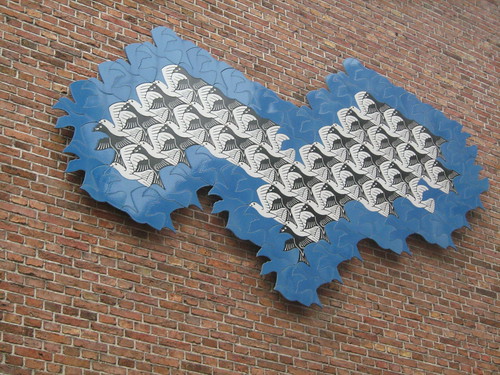

Top photograph by versluis, 2004 — Credit for the close-up photograph below it is from SmitoniusAndSonata, all rights reserved.
Pictured above are ceramic tiles on the exterior wall of the Princessehof Ceramics Museum in Leeuwarden, The Netherlands. The design is based on M.C. Escher’s 1949 woodcut titled the “Regular Division of the Plane With Birds.” The piece commemorates the fact that M.C. (Maurits Cornelis) Escher (1898–1972) was born in Leeuwarden.
Escher felt that the regular division of the plane using contiguous shapes was one of the most interesting problems he dealt with. In an essay titled “Coloured Symmetry” Prof. H.S.M. Coxeter quotes Escher as saying:
“A plane, which should be considered limitless on all sides, can be filled with or divided into similar geometric figures that border each other on all sides without leaving any ‘empty spaces’. This can be carried on to infinity according to a limited number of systems.”[1]
Escher goes on to say this about his interest in the motifs of animal shapes:
“… My experience has taught me that the silhouettes of birds and fish are the most gratifying shapes of all for use in the game of dividing the plane. The silhouette of a flying bird has just the necessary angularity, while the bulges and indentations in the outline are neither too pronounced nor too subtle ….”[2]
- Coxeter, H. S. M. “Coloured Symmetry.” M.C. Escher: Art and Science. Ed. H. S. M. Coxeter, M. Emmer, R. Penrose, and M. L. Teuber. 2nd ed. Amsterdam: Elsevier Science Publishers B.V., 1987. 15. Print.
- Ibid. 16.


No comments:
Post a Comment
Comments are moderated, and will not appear until the editor has approved them.